标签:tput 化学 rgb charset 字节数组 let 字符编码 font 部分
1.文件
1.1.什么是文件?
答:文件可认为是相关记录或放在一起的数据的集合
1.2.文件- -般存储在哪里?
答: 磁盘,硬盘,文件夹
1.3.JAVA程序如何访向文件属性?
JAVA API:iava.io. File类

2.File类的常用方法
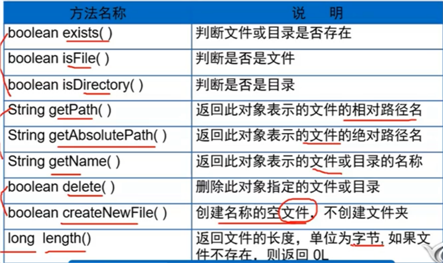
1 /** 2 * 案例1:使用文件操作的9大方法完成文件的判断 3 */ 4 import java.io.*;//1.导入接口 5 import java.util.*; 6 public class TestFileMethods { 7 public static void main(String[] args) { 8 9 try { 10 Text(); 11 } catch (IOException e) { 12 e.printStackTrace(); 13 } 14 } 15 public static void Text() throws IOException { 16 Scanner input=new Scanner(System.in); 17 //2.实例化对象指定的路径 18 File file=new File("D:\\JAVA\\IDEA\\javaS2\\第8章 File类\\hello.txt");//填写路径 19 //3.判断hello.txt路径是否存在,exists() 20 if (file.exists()){ 21 if (file.isDirectory()){ 22 System.out.println("当前路径是文件夹"); 23 }else{ 24 System.out.println("当前路径是文件"); 25 System.out.println("当前文件存在"); 26 System.out.println("文件的相对路径,完整路径:"+file.getPath()); 27 System.out.println("文件的名字为:"+file.getName()); 28 System.out.println("文件的绝对路径"+file.getAbsolutePath()); 29 System.out.println("文件的上一级目录"+file.getParent()); 30 System.out.println("文件的长度是:"+file.length()); 31 } 32 System.out.print("按1删除文件:"); 33 int an=input.nextInt(); 34 if (an==1){ 35 //删除操作 36 boolean teue=file.delete(); 37 if (teue){ 38 System.out.println("删除成功"); 39 }else { 40 System.out.println("删除失败"); 41 } 42 } 43 44 }else { 45 System.out.println("当前文件不存在"); 46 //4.创建hello文件 47 boolean bool=file.createNewFile(); 48 if (bool){ 49 System.out.println("hello文件创建成功"); 50 }else { 51 System.out.println("hello文件创建失败"); 52 } 53 } 54 } 55 }

3.JAVA的流
理解Java的流和流的分类
3.1.如何读写文件?
答:通过流来读写文件,流是指一连串流动的字符是以先进先出方式发送信息的通道
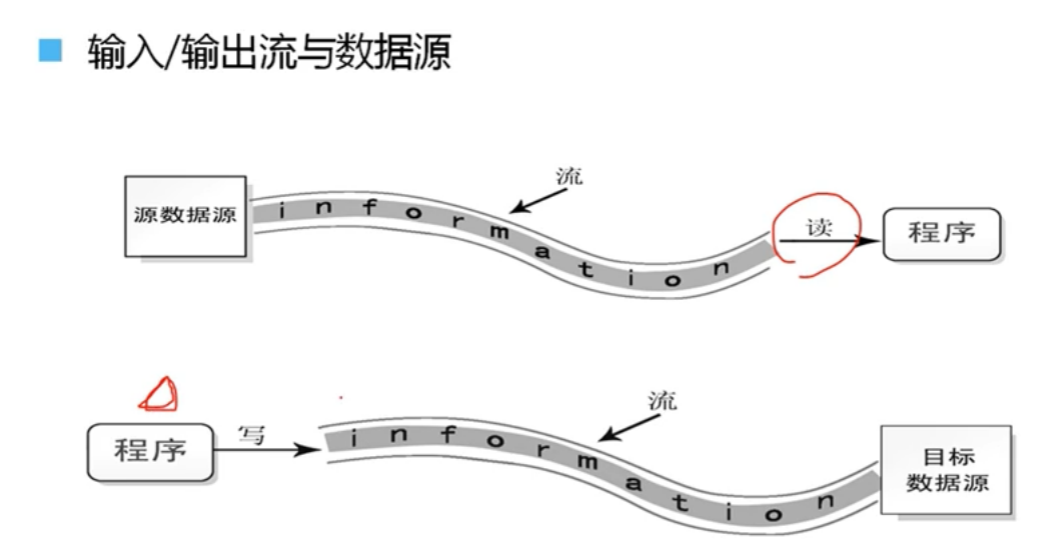


字节流读写文本文件
1.文件的读写
1.1.文本文件的读写
1.2.二进制文件的读写
使用DataInputStream和DataOutputStream读写二进制文件
2.字节流
2.1.输入流
基类: InputStream
子类: FileInputStream
构造:
FileInputStream(File file)
FileInputStream (String name)
方法:
int read() 按字节读返回读到的字节
read (byte[ ] b) 读到字节数组返回读入字节数组的长度
read (byte[ ] b, int off, int len) 到字节数组返回读入字节数组的长度
1 /** 2 * 使用字节流来操作文本文件 读 3 */ 4 import java.io.FileInputStream;//1.引入相关类 5 import java.io.FileNotFoundException; 6 import java.io.IOException; 7 import java.io.InputStream; 8 9 public class FileInputstreamDemo { 10 public static void main(String[] args) { 11 //创建字节输入流 12 InputStream in=null; 13 try { 14 in =new FileInputStream("D:\\hello.txt"); 15 int data;//存储读到的字节 16 //实现读取操作 17 while((data=in.read())!=-1){ 18 System.out.print((char) data); 19 } 20 } catch (IOException e) { 21 e.printStackTrace(); 22 } 23 //关闭流 24 finally { 25 try { 26 if (in!=null){//判断文件是否为空 27 in.close(); 28 } 29 30 } catch (IOException e) { 31 e.printStackTrace(); 32 } 33 } 34 35 } 36 }
1 /** 2 * 使用字节流来操作文本文件 3 */ 9 public class FileInputstreamDemo { 10 public static void main(String[] args) { 11 //创建字节输入流 12 InputStream in=null; 13 try { 14 in =new FileInputStream("D:\\hello.txt"); 15 //使用数组的方式来读取文件,这可以识别中文字符 16 int len;//存取读入数组的长度 17 byte[]words=new byte[1024]; 18 while ((len=in.read(words))!=-1){ 19 System.out.println(new String(words,0,len)); 20 } 21 } catch (IOException e) { 22 e.printStackTrace(); 23 } 24 //关闭流 25 finally { 26 try { 27 if (in!=null){//判断文件是否为空 28 in.close(); 29 } 30 31 } catch (IOException e) { 32 e.printStackTrace(); 33 } 34 } 35 36 } 37 }
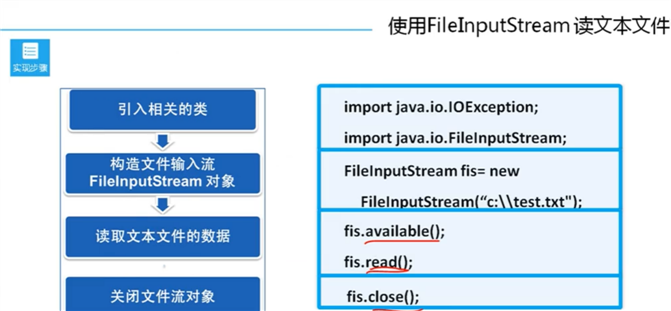
3.小节
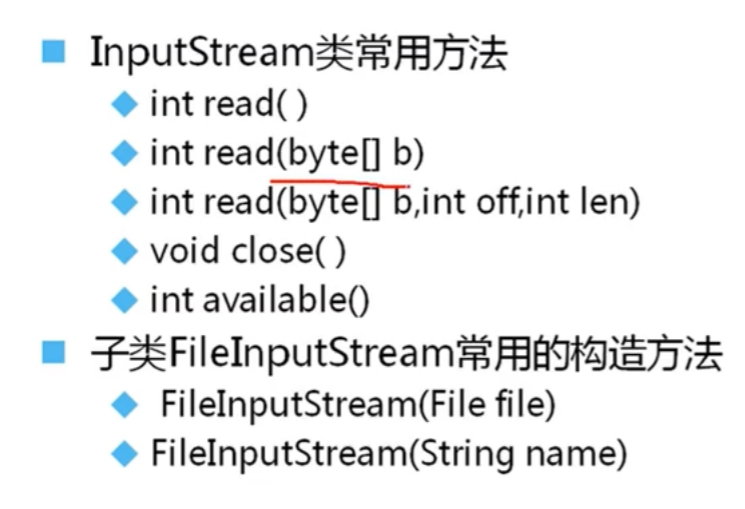
4.输出流
基类: OutputStream
子类: FileOutputStream
构造:
Fil eOutputStream(File file)
Fil eOutputStream (String name)
Fi 1 eOutputStream (String name, boolean append) true
追加写.
方法:
close ()
flush() 刷新缓冲区
write (byte[] b)
write (byte门b, int off, int len) .
write(int b)
1 import java.io.File; 2 import java.io.FileNotFoundException; 3 import java.io.FileOutputStream; 4 import java.io.IOException; 5 6 /** 7 * 案例 8 * 将字符串中的信息写出到文本文件 9 */ 10 public class FileOutputStreamDemo { 11 public static void main(String[] args) { 12 //1.创建字节输出流 13 FileOutputStream fos=null; 14 try { 15 fos=new FileOutputStream(new File("D:\\学好JAVA.txt"),true);//表示是否可以追加 16 //2.执行写操作 17 String str="HrlloWord学好JAVA";//要写入的字符 18 byte[] by=str.getBytes();//将字符转换为数组 19 fos.write(by,0,by.length); 20 System.out.println("文件更新成功"); 21 } catch (FileNotFoundException e) { 22 e.printStackTrace(); 23 }catch (IOException e){ 24 e.printStackTrace(); 25 } 26 finally { 27 //3.关闭流 28 if (fos!=null){ 29 try { 30 fos.close(); 31 } catch (IOException e) { 32 e.printStackTrace(); 33 } 34 } 35 } 36 37 38 } 39 }
4.1.案例:将一个文本中的内容复制到另一个文本中
1 import java.io.FileInputStream; 2 import java.io.FileOutputStream; 3 import java.io.IOException; 4 import java.nio.charset.StandardCharsets; 5 6 public class Texst { 7 public static void main(String[] args) { 8 FileInputStream inputStream=null; 9 FileOutputStream outputStream=null; 10 11 try { 12 inputStream=new FileInputStream("D:\\学好JAVA.txt"); 13 outputStream=new FileOutputStream("D:\\hello.txt",true); 14 int num; 15 byte[]str=new byte[1024]; 16 String stow; 17 while ((num=inputStream.read(str))!=-1){ 18 System.out.println(stow=new String(str,0,num)); 19 byte[]sum=stow.getBytes(StandardCharsets.UTF_8); 20 outputStream.write(sum,0, sum.length); 21 System.out.println("复制成功"); 22 } 23 } catch (IOException e) { 24 e.printStackTrace(); 25 } 26 } 27 }
小结
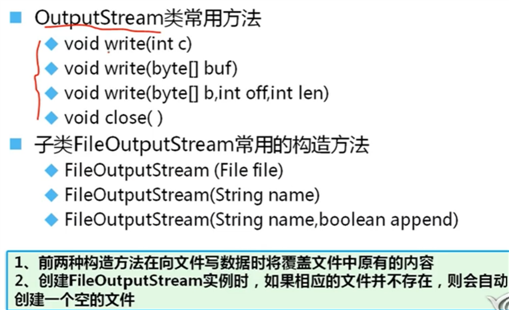
字符流和缓冲流读取文本文件
//存取读入数组的长度
------------恢复内容开始------------
1.文件
1.1.什么是文件?
答:文件可认为是相关记录或放在一起的数据的集合
1.2.文件- -般存储在哪里?
答: 磁盘,硬盘,文件夹
1.3.JAVA程序如何访向文件属性?
JAVA API:iava.io. File类

2.File类的常用方法

1 /** 2 * 案例1:使用文件操作的9大方法完成文件的判断 3 */ 4 import java.io.*;//1.导入接口 5 import java.util.*; 6 public class TestFileMethods { 7 public static void main(String[] args) { 8 9 try { 10 Text(); 11 } catch (IOException e) { 12 e.printStackTrace(); 13 } 14 } 15 public static void Text() throws IOException { 16 Scanner input=new Scanner(System.in); 17 //2.实例化对象指定的路径 18 File file=new File("D:\\JAVA\\IDEA\\javaS2\\第8章 File类\\hello.txt");//填写路径 19 //3.判断hello.txt路径是否存在,exists() 20 if (file.exists()){ 21 if (file.isDirectory()){ 22 System.out.println("当前路径是文件夹"); 23 }else{ 24 System.out.println("当前路径是文件"); 25 System.out.println("当前文件存在"); 26 System.out.println("文件的相对路径,完整路径:"+file.getPath()); 27 System.out.println("文件的名字为:"+file.getName()); 28 System.out.println("文件的绝对路径"+file.getAbsolutePath()); 29 System.out.println("文件的上一级目录"+file.getParent()); 30 System.out.println("文件的长度是:"+file.length()); 31 } 32 System.out.print("按1删除文件:"); 33 int an=input.nextInt(); 34 if (an==1){ 35 //删除操作 36 boolean teue=file.delete(); 37 if (teue){ 38 System.out.println("删除成功"); 39 }else { 40 System.out.println("删除失败"); 41 } 42 } 43 44 }else { 45 System.out.println("当前文件不存在"); 46 //4.创建hello文件 47 boolean bool=file.createNewFile(); 48 if (bool){ 49 System.out.println("hello文件创建成功"); 50 }else { 51 System.out.println("hello文件创建失败"); 52 } 53 } 54 } 55 }

3.JAVA的流
理解Java的流和流的分类
3.1.如何读写文件?
答:通过流来读写文件,流是指一连串流动的字符是以先进先出方式发送信息的通道



字节流读写文本文件
1.文件的读写
1.1.文本文件的读写
1.2.二进制文件的读写
使用DataInputStream和DataOutputStream读写二进制文件
2.字节流
2.1.输入流
基类: InputStream
子类: FileInputStream
构造:
FileInputStream(File file)
FileInputStream (String name)
方法:
int read() 按字节读返回读到的字节
read (byte[ ] b) 读到字节数组返回读入字节数组的长度
read (byte[ ] b, int off, int len) 到字节数组返回读入字节数组的长度
1 /** 2 * 使用字节流来操作文本文件 读 3 */ 4 import java.io.FileInputStream;//1.引入相关类 5 import java.io.FileNotFoundException; 6 import java.io.IOException; 7 import java.io.InputStream; 8 9 public class FileInputstreamDemo { 10 public static void main(String[] args) { 11 //创建字节输入流 12 InputStream in=null; 13 try { 14 in =new FileInputStream("D:\\hello.txt"); 15 int data;//存储读到的字节 16 //实现读取操作 17 while((data=in.read())!=-1){ 18 System.out.print((char) data); 19 } 20 } catch (IOException e) { 21 e.printStackTrace(); 22 } 23 //关闭流 24 finally { 25 try { 26 if (in!=null){//判断文件是否为空 27 in.close(); 28 } 29 30 } catch (IOException e) { 31 e.printStackTrace(); 32 } 33 } 34 35 } 36 }
1 /** 2 * 使用字节流来操作文本文件 3 */ 9 public class FileInputstreamDemo { 10 public static void main(String[] args) { 11 //创建字节输入流 12 InputStream in=null; 13 try { 14 in =new FileInputStream("D:\\hello.txt"); 15 //使用数组的方式来读取文件,这可以识别中文字符 16 int len;//存取读入数组的长度 17 byte[]words=new byte[1024]; 18 while ((len=in.read(words))!=-1){ 19 System.out.println(new String(words,0,len)); 20 } 21 } catch (IOException e) { 22 e.printStackTrace(); 23 } 24 //关闭流 25 finally { 26 try { 27 if (in!=null){//判断文件是否为空 28 in.close(); 29 } 30 31 } catch (IOException e) { 32 e.printStackTrace(); 33 } 34 } 35 36 } 37 }

3.小节

4.输出流
基类: OutputStream
子类: FileOutputStream
构造:
Fil eOutputStream(File file)
Fil eOutputStream (String name)
Fi 1 eOutputStream (String name, boolean append) true
追加写.
方法:
close ()
flush() 刷新缓冲区
write (byte[] b)
write (byte门b, int off, int len) .
write(int b)
1 import java.io.File; 2 import java.io.FileNotFoundException; 3 import java.io.FileOutputStream; 4 import java.io.IOException; 5 6 /** 7 * 案例 8 * 将字符串中的信息写出到文本文件 9 */ 10 public class FileOutputStreamDemo { 11 public static void main(String[] args) { 12 //1.创建字节输出流 13 FileOutputStream fos=null; 14 try { 15 fos=new FileOutputStream(new File("D:\\学好JAVA.txt"),true);//表示是否可以追加 16 //2.执行写操作 17 String str="HrlloWord学好JAVA";//要写入的字符 18 byte[] by=str.getBytes();//将字符转换为数组 19 fos.write(by,0,by.length); 20 System.out.println("文件更新成功"); 21 } catch (FileNotFoundException e) { 22 e.printStackTrace(); 23 }catch (IOException e){ 24 e.printStackTrace(); 25 } 26 finally { 27 //3.关闭流 28 if (fos!=null){ 29 try { 30 fos.close(); 31 } catch (IOException e) { 32 e.printStackTrace(); 33 } 34 } 35 } 36 37 38 } 39 }
4.1.案例:将一个文本中的内容复制到另一个文本中
1 import java.io.FileInputStream; 2 import java.io.FileOutputStream; 3 import java.io.IOException; 4 import java.nio.charset.StandardCharsets; 5 6 public class Texst { 7 public static void main(String[] args) { 8 FileInputStream inputStream=null; 9 FileOutputStream outputStream=null; 10 11 try { 12 inputStream=new FileInputStream("D:\\学好JAVA.txt"); 13 outputStream=new FileOutputStream("D:\\hello.txt",true); 14 int num; 15 byte[]str=new byte[1024]; 16 String stow; 17 while ((num=inputStream.read(str))!=-1){ 18 System.out.println(stow=new String(str,0,num)); 19 byte[]sum=stow.getBytes(StandardCharsets.UTF_8); 20 outputStream.write(sum,0, sum.length); 21 System.out.println("复制成功"); 22 } 23 } catch (IOException e) { 24 e.printStackTrace(); 25 } 26 } 27 }
小结

字符流和缓冲流读取文本文件
1.字符编码:
ASCII码 0~127 8位二进制数1个字节 16位二进制数(2个字节) 010101001010 0^ 65535
Unicode编码格式
字符流
1.输入流
基类: Reader
FileReader
构造:
FileReader (File file)
FileReader (String name)
常用方法:
int read() 读取-一个字符返回字符编码
int read (char[] b)读取到一个字符数组」_
int read (char[] b, int off, int len) 读取到-一个字符数组的某一部分
2.使用FileReader读取文件的步骤

1 import java.io.FileNotFoundException; 2 import java.io.FilterReader; 3 import java.io.IOException; 4 import java.io.Reader; 5 /** 6 * 使用FileReader和StringBuffer,进行文件读取 7 */ 8 public class FileReader { 9 public static void main(String[] args) { 10 Reader reader=null; 11 StringBuilder builder=null; 12 try { 13 //1.创建一个字符流对象 14 reader=new java.io.FileReader("D:\\hello.txt"); 15 16 /*int num;//接受读到的字节 17 //2.读取文本文件 18 while ((num= reader.read())!=-1){ 19 System.out.print((char) num);//吧读到的字节进行类型转换 20 }*/ 21 char[]sum=new char[1024];//存取读到的字节 22 builder=new StringBuilder();//把字节进行重组 23 int word;//接受读到的字节 24 while ((word= reader.read(sum))!=-1){ 25 builder.append(sum); 26 System.out.println(builder.toString()); 27 } 28 29 } catch (IOException e) { 30 e.printStackTrace(); 31 }finally { 32 //3.关闭流 33 if (reader!=null){ 34 try { 35 reader.close(); 36 } catch (IOException e) { 37 e.printStackTrace(); 38 } 39 } 40 41 } 42 43 } 44 }
3.BufferedReader类
3.1. 问题: 如何提高字符流读取文本文件的效率?
使用FileReader类与BufferedReader类
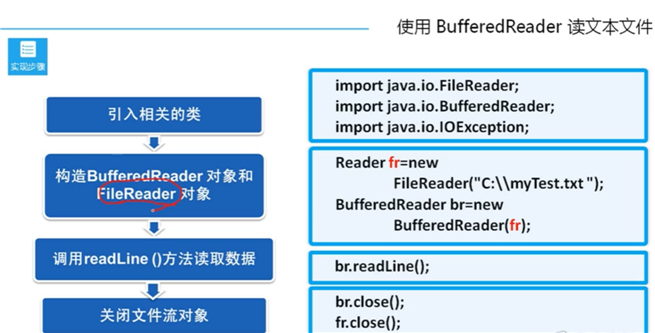
■Reader类常用方法
int read()
int read(char[ ch)
read(charD c,int off,int len)
void close( )
■子 类BufferedReader常用的构造方法
BufferedReader(Reader in)
■子 类BufferedReader特有的方法
readLine() 按行读取
4.使用字符流写文本文件
4.1.输出流
基类: Writer
FileWriter
构造: FileWriter (File file)
FIleWriter(File file, boolean append) append表示是否是追加写, true 是
FileWriter (String name)
FileWriter (String name, boolean append)
方法:
close ()
flush()刷新缓冲区
write(int c)
write (char [] ch)
write(char[], int off, int len)
write (String str)
write (String str, int off, int len)
4.2.使用 FileWriter对文本进行写入的操作
1 import java.io.FileWriter; 2 import java.io.IOException; 3 import java.io.Writer; 4 /** 5 * 使用FileWriterDemo向文本文件中写信息 6 */ 7 public class FileWriterDemo { 8 public static void main(String[] args) { 9 //1.创建流 10 Writer writer=null; 11 try { 12 writer=new FileWriter("D:\\我的世界.txt",true); 13 //2.写入信息 14 writer.write("你好呀,塞罗");//将字符输出到指定的流中 15 writer.flush();//刷新输出流 16 System.out.println("添加成功"); 17 } catch (IOException e) { 18 e.printStackTrace(); 19 }finally { 20 if (writer!=null){ 21 try { 22 //3.关闭流 23 writer.close(); 24 } catch (IOException e) { 25 e.printStackTrace(); 26 } 27 } 28 } 29 } 30 }
4.3.使用BufferedWriter向文本文件中写信息
1 import java.io.*; 2 import java.io.FileReader; 3 4 /** 5 * 使用BufferedWriter向文本文件中写信息 6 */ 7 public class BufferedWriterDemo { 8 public static void main(String[] args) { 9 Writer wr=null; 10 BufferedWriter br=null; 11 Reader re=null; 12 BufferedReader der=null; 13 try { 14 //1.创建流 15 br=new BufferedWriter(wr=new FileWriter("D:\\我是钢铁侠.txt")); 16 //2.写入信息 17 br.write("你哈钢铁侠我是你的粉丝"); 18 br.newLine();//换行的意思 19 br.write("你的知识可以传给我吗"); 20 br.newLine(); 21 br.write("我真的很需要你的知识"); 22 br.flush();//一定要记得写缓冲区 23 24 //读取文件中的信息 25 der=new BufferedReader(re=new FileReader("D:\\我是钢铁侠.txt")); 26 String str=null;//接收读取到的信息 27 while ((str=der.readLine())!=null){ 28 System.out.println(str); 29 } 30 } catch (IOException e) { 31 e.printStackTrace(); 32 }finally { 33 try { 34 //3.关闭流 35 wr.close(); 36 } catch (IOException e) { 37 e.printStackTrace(); 38 } 39 if (re!=null){ 40 try { 41 re.close(); 42 } catch (IOException e) { 43 e.printStackTrace(); 44 } 45 } 46 } 47 48 } 49 }
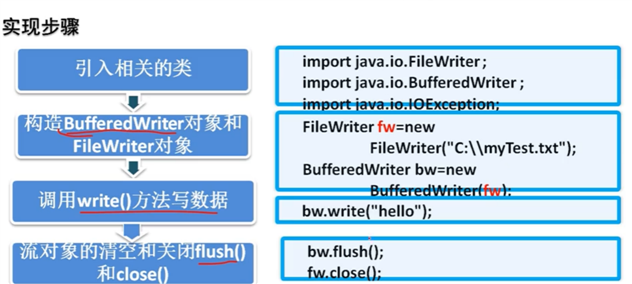 总结:
总结:
读写二-进制文件
1.DataInputStream类
■FilterInputStream的子类
■与FileInputStream类结合 使用读取二进制文件
2.DataOutputStream类
■FilterOutputStream的子 类
■与FileOutputStream类结合使用写二 进制文件
3.使用DataInputStream读二进制文件 使用DataOutputStream写=进制文件
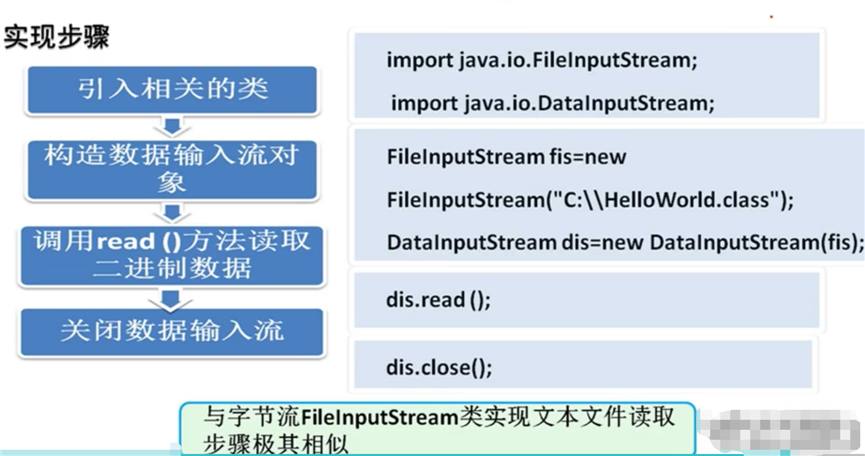

1 import java.io.*; 2 3 /** 4 * 使用DataInputStream和DataOutputStream读写文件 一般用于一些二进制文件 5 */ 6 public class ReadAndWriteBinaryFile { 7 public static void main(String[] args) { 8 //1.创建流 9 DataInputStream stream=null; 10 DataOutput output=null; 11 try { 12 stream=new DataInputStream(new FileInputStream("D:\\BufferedWriterDemo.class"));//读取文件 13 output=new DataOutputStream(new FileOutputStream("D:\\FileOutputStream.class")); 14 int sum; 15 //2.实现读写操作 16 while ((sum=stream.read())!=-1){ 17 output.write(sum); 18 } 19 } catch (IOException e) { 20 e.printStackTrace(); 21 }finally { 22 //3.关闭流 23 if (stream!=null){ 24 try { 25 stream.close(); 26 } catch (IOException e) { 27 e.printStackTrace(); 28 } 29 } 30 } 31 } 32 }
序列化和反序列化
1.序列化和反序列化的过程

序列化是将对象的状态写入到特定的流中的过程
反序列化则是从特定的流中获取数据重新构建对象的过程
1.1.实现序列化

1 /** 2 * 学生类 3 */ 4 public class Student implements java.io.Serializable{ 5 6 private static final long serialVersionUID=1l; 7 8 private String name;//姓名 9 private int age;//年龄 10 transient private String gender;//性别 11 public Student(String name,int age,String gender){ 12 this.name=name; 13 this.age= age; 14 this.gender=gender; 15 } 16 public String getName() { 17 return name; 18 } 19 public void setName(String name) { 20 this.name = name; 21 } 22 public int getAge() { 23 return age; 24 } 25 public void setAge(int age) { 26 this.age = age; 27 } 28 public String getGender() { 29 return gender; 30 } 31 public void setGender(String gender) { 32 this.gender = gender; 33 } 34 }
1 import java.io.*; 2 3 /** 4 * 序列化学生对象 5 */ 6 public class Serizable0bj { 7 public static void main(String[] args) throws ClassNotFoundException { 8 //1.创建一个需要序列化的学生对象 9 Student dent=new Student("王饱饱",21,"男"); 10 //2.创建一个对象流 11 OutputStream os=null; 12 ObjectOutputStream oos=null; 13 //3.创建一个对象输入流 14 FileInputStream is=null; 15 ObjectInputStream ois=null; 16 try { 17 os=new FileOutputStream("D:/studer.bin"); 18 oos=new ObjectOutputStream(os); 19 oos.writeObject(dent); 20 21 is=new FileInputStream("D:/studer.bin"); 22 ois=new ObjectInputStream(is); 23 Student stu=(Student) ois.readObject(); 24 System.out.println("学生姓名:"+stu.getName()+" 年龄:"+stu.getAge()+" 性别:"+stu.getGender()); 25 26 } catch (FileNotFoundException e) { 27 e.printStackTrace(); 28 }catch (IOException e) { 29 e.printStackTrace(); 30 }finally { 31 if (oos!=null){ 32 try { 33 //.关闭 34 oos.close(); 35 } catch (IOException e) { 36 e.printStackTrace(); 37 } 38 } 39 if (is!=null){ 40 try { 41 is.close(); 42 } catch (IOException e) { 43 e.printStackTrace(); 44 } 45 } 46 } 47 48 } 49 }
------------恢复内容结束------------
标签:tput 化学 rgb charset 字节数组 let 字符编码 font 部分
原文地址:https://www.cnblogs.com/pindao111/p/14387117.html